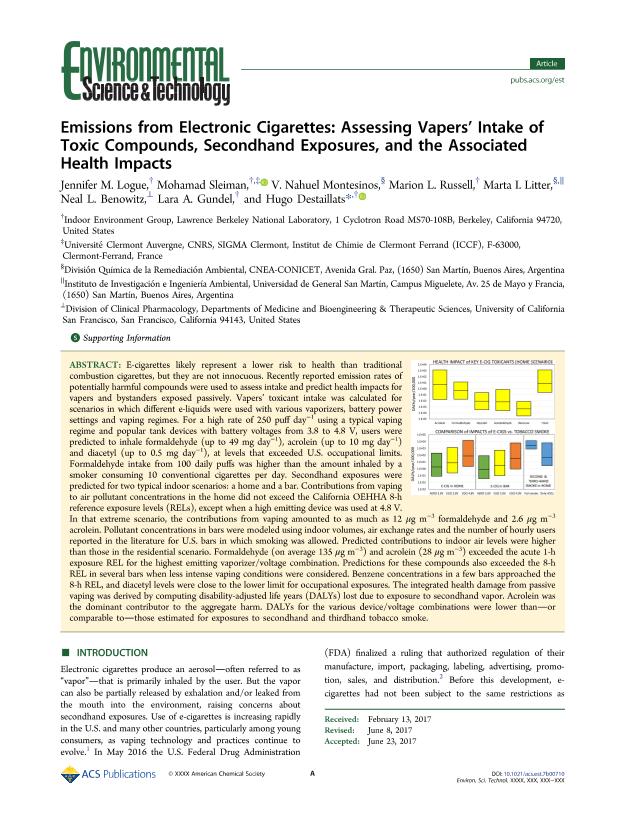Artículo
Emissions from Electronic Cigarettes: Assessing Vapers’ Intake of Toxic Compounds, Secondhand Exposures, and the Associated Health Impacts
Logue, Jennifer M.; Sleiman, Mohamad; Montesinos, Victor Nahuel ; Russell, Marion L.; Litter, Marta Irene
; Russell, Marion L.; Litter, Marta Irene ; Benowitz, Neal L.; Gundel, Lara A.; Destaillats, Hugo
; Benowitz, Neal L.; Gundel, Lara A.; Destaillats, Hugo
 ; Russell, Marion L.; Litter, Marta Irene
; Russell, Marion L.; Litter, Marta Irene ; Benowitz, Neal L.; Gundel, Lara A.; Destaillats, Hugo
; Benowitz, Neal L.; Gundel, Lara A.; Destaillats, Hugo
Fecha de publicación:
08/2017
Editorial:
American Chemical Society
Revista:
Environmental Science & Technology
ISSN:
0013-936X
Idioma:
Inglés
Tipo de recurso:
Artículo publicado
Clasificación temática:
Resumen
E-cigarettes likely represent a lower risk to health than traditional combustion cigarettes, but they are not innocuous. Recently reported emission rates of potentially harmful compounds were used to assess intake and predict health impacts for vapers and bystanders exposed passively. Vapers' toxicant intake was calculated for scenarios in which different e-liquids were used with various vaporizers, battery power settings and vaping regimes. For a high rate of 250 puff day-1 using a typical vaping regime and popular tank devices with battery voltages from 3.8 to 4.8 V, users were predicted to inhale formaldehyde (up to 49 mg day-1), acrolein (up to 10 mg day-1) and diacetyl (up to 0.5 mg day-1), at levels that exceeded U.S. occupational limits. Formaldehyde intake from 100 daily puffs was higher than the amount inhaled by a smoker consuming 10 conventional cigarettes per day. Secondhand exposures were predicted for two typical indoor scenarios: a home and a bar. Contributions from vaping to air pollutant concentrations in the home did not exceed the California OEHHA 8-h reference exposure levels (RELs), except when a high emitting device was used at 4.8 V. In that extreme scenario, the contributions from vaping amounted to as much as 12 μg m-3 formaldehyde and 2.6 μg m-3 acrolein. Pollutant concentrations in bars were modeled using indoor volumes, air exchange rates and the number of hourly users reported in the literature for U.S. bars in which smoking was allowed. Predicted contributions to indoor air levels were higher than those in the residential scenario. Formaldehyde (on average 135 μg m-3) and acrolein (28 μg m-3) exceeded the acute 1-h exposure REL for the highest emitting vaporizer/voltage combination. Predictions for these compounds also exceeded the 8-h REL in several bars when less intense vaping conditions were considered. Benzene concentrations in a few bars approached the 8-h REL, and diacetyl levels were close to the lower limit for occupational exposures. The integrated health damage from passive vaping was derived by computing disability-adjusted life years (DALYs) lost due to exposure to secondhand vapor. Acrolein was the dominant contributor to the aggregate harm. DALYs for the various device/voltage combinations were lower than - or comparable to - those estimated for exposures to secondhand and thirdhand tobacco smoke.
Archivos asociados
Licencia
Identificadores
Colecciones
Articulos(SEDE CENTRAL)
Articulos de SEDE CENTRAL
Articulos de SEDE CENTRAL
Citación
Logue, Jennifer M.; Sleiman, Mohamad; Montesinos, Victor Nahuel; Russell, Marion L.; Litter, Marta Irene; et al.; Emissions from Electronic Cigarettes: Assessing Vapers’ Intake of Toxic Compounds, Secondhand Exposures, and the Associated Health Impacts; American Chemical Society; Environmental Science & Technology; 51; 16; 8-2017; 9271-9279
Compartir
Altmétricas



